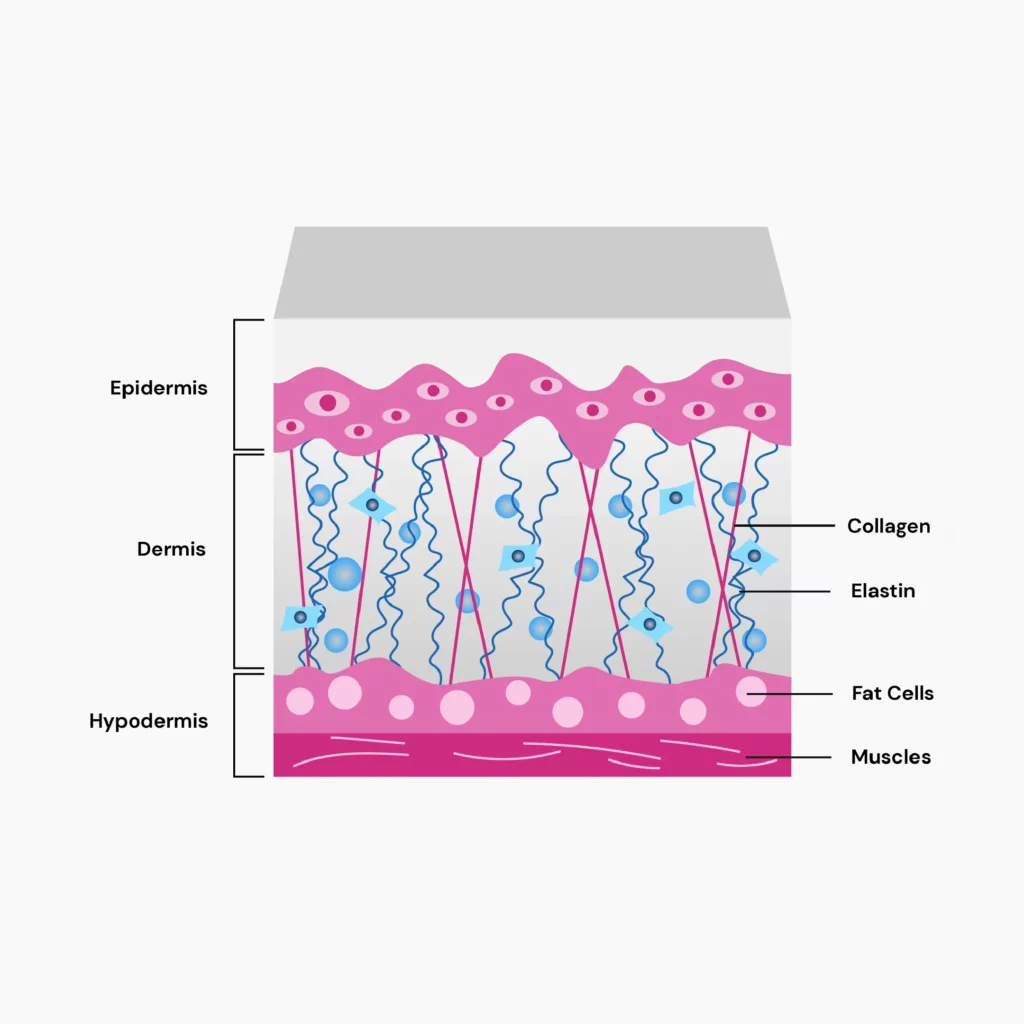What is common in up to 90% of those who are pregnant, 70% of adolescent females, and, surprisingly, 40% of males? Stretch marks! Also known as striae distensae, stretch marks are often a result of sudden weight gain, pregnancy, or growth spurts. Despite this high prevalence, how do some people manage to avoid stretch marks altogether? Is it due to a religious coconut oil sugar scrub routine, or are there some hidden genetic factors at play? This article delves into the hereditary nature of stretch marks and explores whether they could be genetic.
How Are Stretch Marks Formed?
Striae distensae or stretch marks are scars that develop in the skin when it expands or shrinks. This puts excess pressure on the collagen and elastin that support the skin, ultimately causing breakage in them. This leads to the appearance of scars.
While stretch marks are not medically serious, they can affect a person’s appearance. Females are at a higher risk of developing stretch marks than males.
Stretch marks commonly appear on the abdomen, breasts, shoulders, and thighs. In children experiencing growth spurts, you can also see stretch marks on the thighs and buttocks.
What Do Stretch Marks Look Like?
Stretch marks start out as thin pink or pale-colored lines on the skin. As they develop, lines perpendicular to the skin tension start developing.
These lines look slightly swollen and can turn pink or purple in color. Mature stretch marks are pale-white in color.

Are Stretch Marks Genetic?
Genetics is one of the most significant factors that contribute to stretch mark development. There's no one "stretch mark gene," but a group of genes that regulate skin elasticity, collagen, etc., together influence the risk of stretch marks.
According to a study, females with a family history of stretch marks were more likely to develop them during pregnancy, further supporting the role of genetic factors in the development of stretch marks.
Let's explore some genes known to be involved in stretch marks.
ELN Gene and Stretch Marks
The ELN gene helps produce a type of protein called tropoelastin.
Multiple copies of this protein join together to become elastin fibers. They provide stretch, recoil, and elasticity to the skin.
Certain changes in the ELN gene can interfere with the normal functioning of elastin protein, leaving the individual susceptible to stretch marks.
The T allele of the rs7787362 SNP (an SNP is a single-letter change) in the ELN gene is associated with an increased risk for stretch marks.
FN1 Gene and Stretch Marks
The FN1 gene produces two types of proteins - cellular fibronectin-1 and plasma fibronectin-1.
Plasma fibronectin-1 attaches itself to other proteins in the skin, including.
This helps strengthen the tissues and helps repair them, too.
Certain changes in this gene result in lower fibronectin levels, which may result in poor tissue repair, increasing the risk of stretch marks.
The A allele of the rs3910516 SNP in the FN1 gene is associated with an increased risk for stretch marks.

Non-genetic Influences on Stretch Marks
Pregnancy
Pregnancy is the biggest non-genetic influence on stretch marks.
But the tendency to develop even pregnancy stretch marks can be genetic!
About 90% of women develop stretch marks during pregnancy and continue handling them for the rest of their lives.
Women with larger abdominal areas and more weight gain during the pregnancy period develop severe striae distensae.
Overweight and Obesity
Up to 43% of people who are overweight and obese develop striae distensae in their lifetimes.
The increase in weight puts more stress on the skin.
As a result, it stretches it beyond its usual capacity, leading to stretch marks.
Cushing Syndrome
Cushing syndrome is a result of excess cortisol hormone in the body.
Cortisol is an important hormone that reduces inflammation, regulates blood pressure, and helps the body handle stress.
Cortisol-based drugs are prescribed to handle inflammatory diseases and chronic pain. Sometimes, the body overproduces this hormone. This results in Cushing syndrome.
The main symptom of Cushing syndrome is the development of stretch marks (pink and purple lines) all over the breast, buttocks, abdomen, thighs, and shoulders.
Other Health Conditions
Some conditions like anorexia nervosa, Marfan syndrome, and chronic liver diseases can make an individual prone to developing stretch marks.
Corticosteroid Creams
Corticosteroid creams, lotions, and gels are prescribed to treat conditions like eczema, itching, dermatitis, and psoriasis.
Corticosteroids can decrease the skin’s ability to stretch and cause stretch marks.
Breast Enlargement Surgery
Those opting for breast enlargement surgeries are at higher risk for developing stretch marks.
Placing an implant under the breast skin causes it to stretch and cover the larger area.
This can lead to the development of striae distensae.
Recommendations To Prevent and Manage Stretch Marks
Avoid Rapid Weight Gain and Weight Loss
Losing and gaining weight gradually will give your skin time to adjust to the new changes and prevent the appearance of stretch marks.
Natural Remedies
Natural remedies work only in the initial stages of stretch marks and not on mature marks. While they may not be able to get rid of the marks completely, they may improve their appearance. Here are a few options you can try out.
- Massage vitamin A-based topical creams (retinoids) on the marks
- Coconut oil can heal the scars on the skin and prevent the initial stages of stretch marks from maturing.
- Olive oil, almond oil, and vitamin E oils can improve skin’s appearance and can be used along with medically recommended topical products for stretch marks.
Dermatological and Cosmeceutical Creams, Lotions, and Gels*
There are two ingredients in topical creams that seem to be effective.
- Tretinoin
- Hyaluronic acid
They are available as over-the-counter medications. These are also only most effective when applied as soon as you spot signs of stretch marks. As the marks get more mature, treating them will be difficult.
Microdermabrasion*
Microdermabrasion is performed by an expert in a clinical setting.
This involves removing the top layers of the skin to help finer and better skin grow back.
Microdermabrasion can help bring down the intensity of striae distensae scars.
Chemical Peels*
Chemical peels are being used widely to bring down the prominence of stretch marks.
These peels remove the topmost or the subsequent layers of the skin and give a faded appearance to stretch marks.
They cannot completely remove the marks, though. Regular chemical peel treatments can harm the skin.
As of now, there is no recommended treatment or lifestyle change that can completely remove stretch marks or prevent them from appearing.
Maintaining a healthy weight, keeping the skin moisturized and hydrated, and treating the early signs of stretch marks help.
*please consult a qualified dermatologist for the best course of action. This is intended for informational purposes only
Hand-picked Content For You: Widows Peak Genetics: Is There An Evolutionary Significance?
Summary
- Stretch marks or Striae distensae are scars that develop in the skin when skin rapidly stretches or shrinks. Stretching and shrinking cause breakage in the collagen and elastin in the skin, leading to the appearance of scars.
- Fibronectin protein attaches to other proteins in the skin to maintain its rigidity. Changes in the FN1 gene (that produces fibronectin) can increase your risk for stretch marks.
- Pregnancy, excessive weight gain or weight loss in minimal time, and conditions like Cushing syndrome, Marfan syndrome, and anorexia nervosa all result in the appearance of stretch marks.
- The use of cortisol-based drugs and topical corticosteroid drugs also contributes to the risk of developing Striae distensae.
- Women who have had breast enlargement surgeries also tend to develop stretch marks on and around the breasts.
- Most natural remedies can prevent the maturing of stretch marks when caught early. Dermatological creams that contain hyaluronic acid and Tretinoin also work on only early marks.
- As of now, no treatment has been able to completely remove the signs of stretch marks in the skin.
References
https://www.mayoclinic.org/diseases-conditions/cushing-syndrome/symptoms-causes/syc-20351310
https://www.ncbi.nlm.nih.gov/pmc/articles/PMC5181654/
https://www.aad.org/public/cosmetic/scars-stretch-marks/stretch-marks-why-appear
https://www.ncbi.nlm.nih.gov/pmc/articles/PMC6615396/
https://www.mayoclinic.org/diseases-conditions/stretch-marks/diagnosis-treatment/drc-20351144
https://emedicine.medscape.com/article/1074868-treatment#d9
https://www.ncbi.nlm.nih.gov/books/NBK436005/
https://pubmed.ncbi.nlm.nih.gov/23579949/




